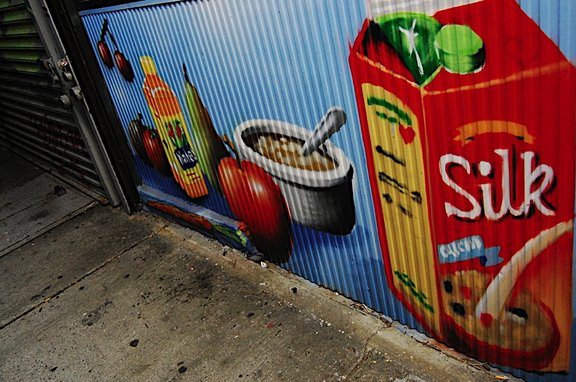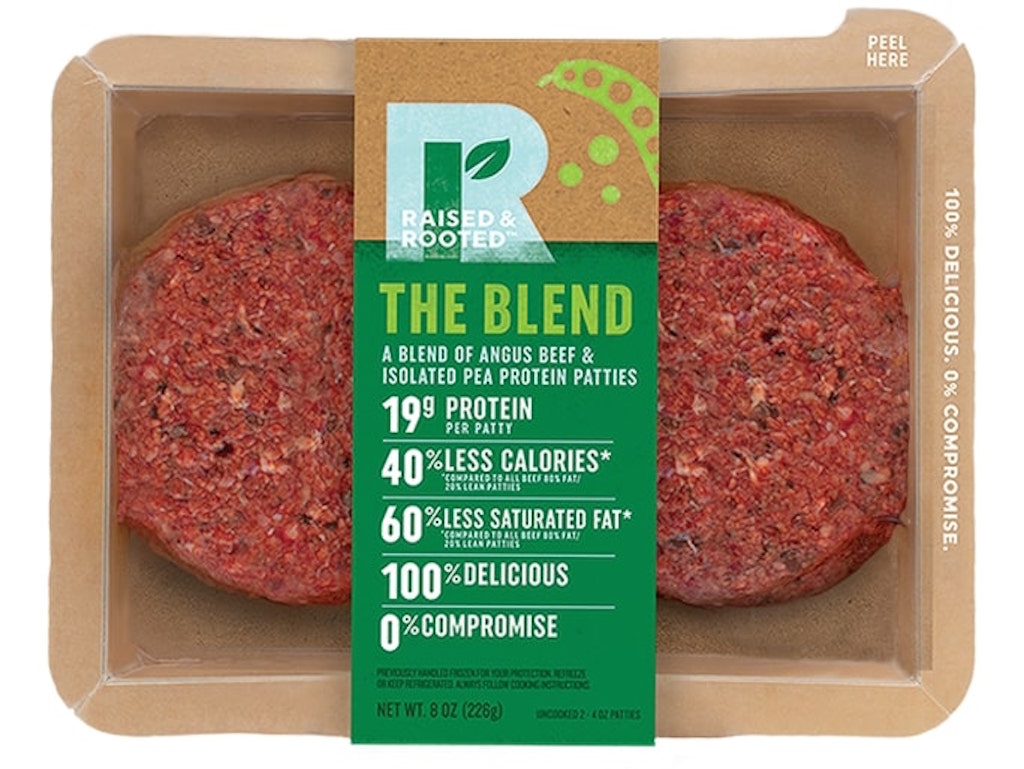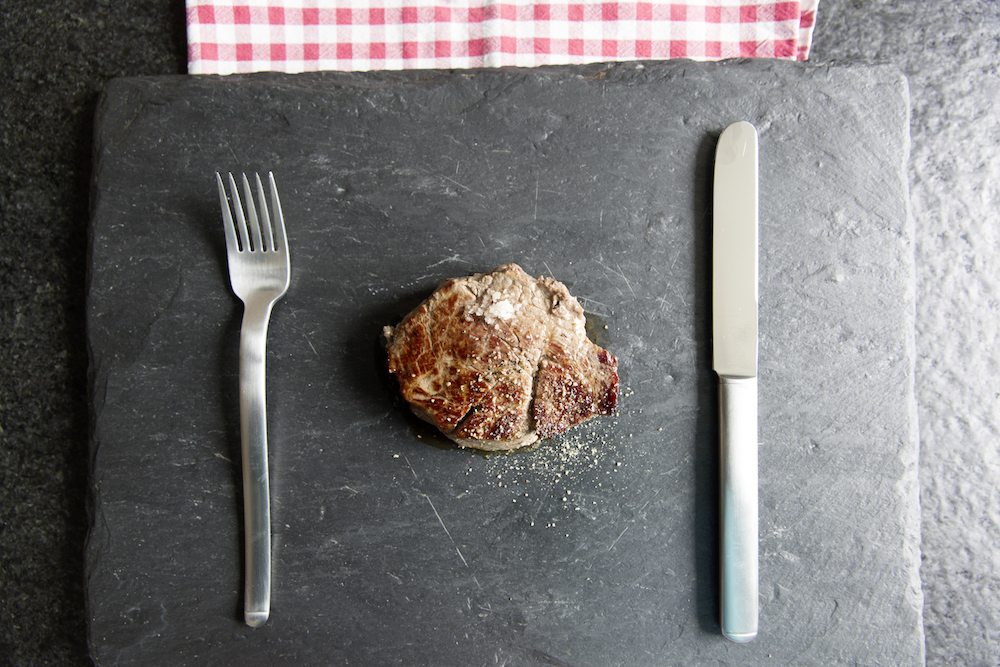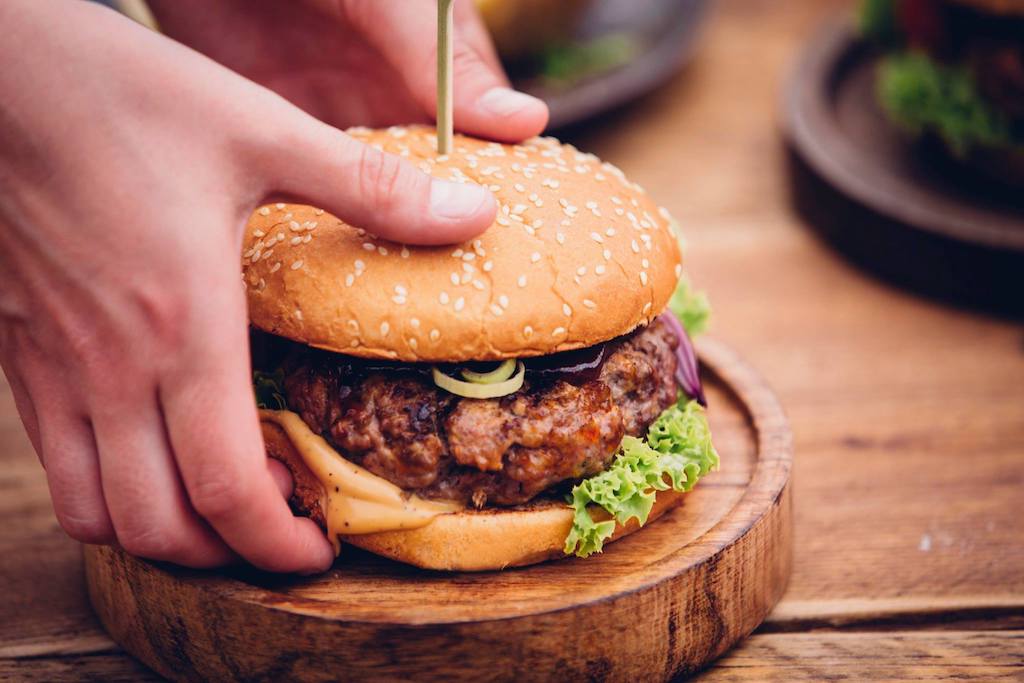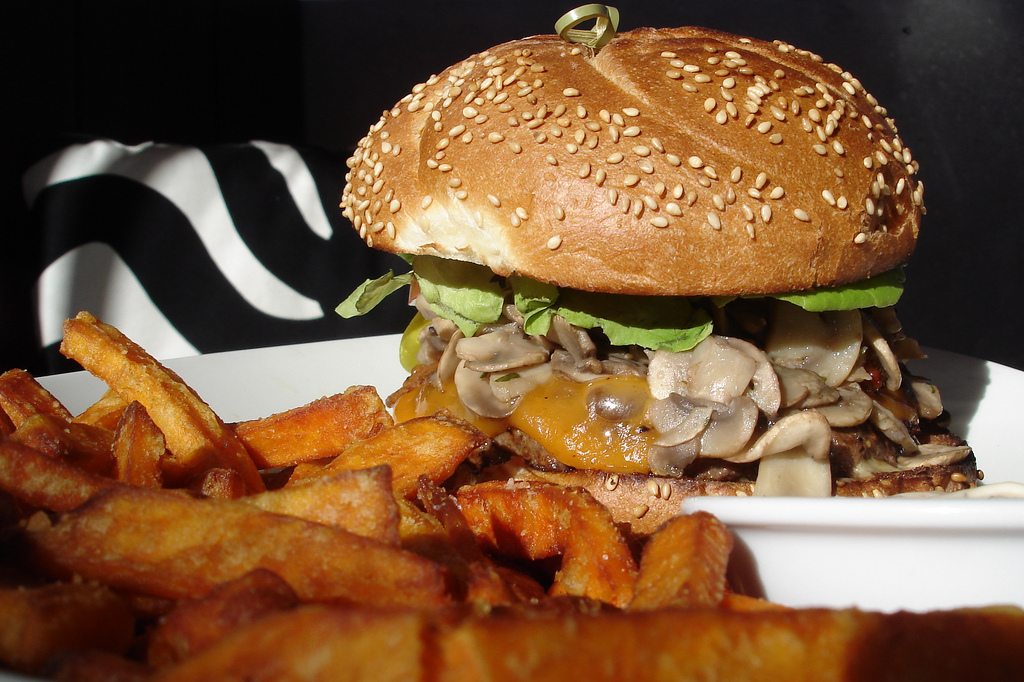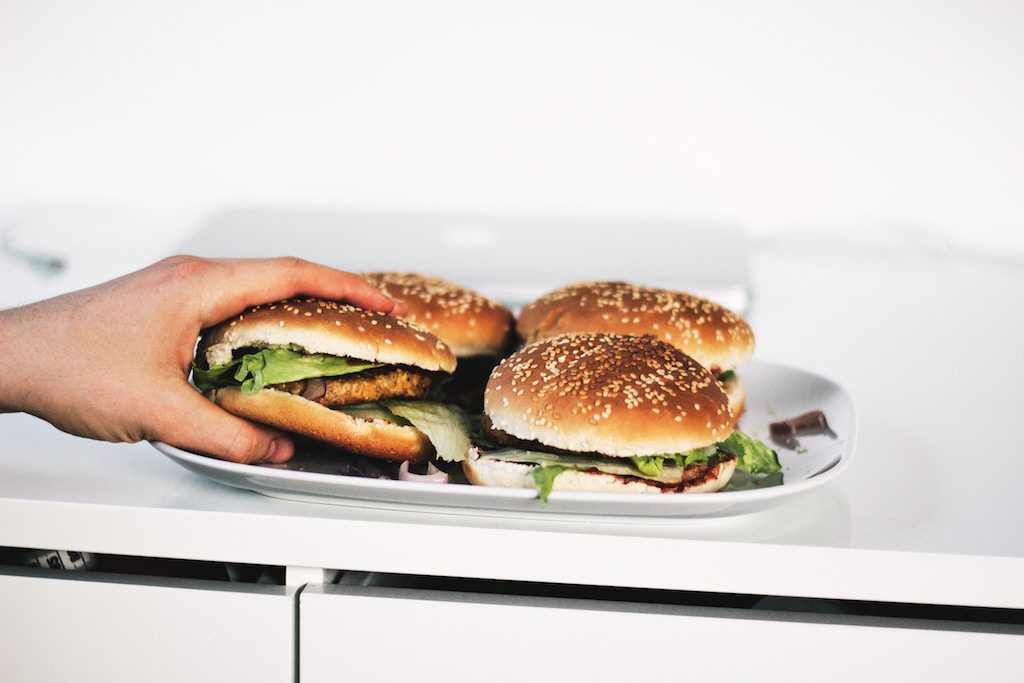
Hillary Bonhomme
Last year, at a home kitchen in San Francisco, Chef Thomas Bowman prepared a radically new kind of meal: chicken nuggets made from a chicken that was still alive.
Editors’ note: After this article was published, Just, Inc. changed the name of its product from “Just Scramble” to “Just Egg.”
This article was a finalist for a 2018 Society for Advancing Business Editing and Writing Award (technology category).
Bowman’s employer, the “alternative protein” company Just—formerly known as Hampton Creek, maker of the much-discussed eggless mayonnaise Just Mayo—found its bird at Fogline Farm, a small, pastured poultry operation in California’s Santa Cruz Mountains. Someone named the bird Ian. The company took a handful of cells from the bony inner shaft of one of Ian’s feathers, and cultivated them further in a proprietary nutritional broth at its San Francisco headquarters. As Ian’s cells fed on plant proteins in a beaker, they began to divide and double, eventually congealing into indeterminate chicken muscle, something not quite breast, thigh, or wing.
Ultimately, Bowman, Just’s “Chef de R & D,” took the lab-grown meat, battered and fried it in oil, and served it as part of a backyard dinner. Biologically, the resulting nuggets were pure Ian. But as the meal was served, Ian the actual bird—blissfully unaware his muscle tissue was being devoured—strutted around the table, healthy and whole.
The event was filmed as a promotional video for Just, one that makes a visually striking point: Not long from now, we’ll be able to quite literally have our chickens and eat them, too. The company tells me that it plans to debut a lab-grown product later this year, and that it’s likely to be in the avian family. We don’t yet know if it will be cultured chicken, or foie gras, or something else entirely—but it will probably entail replicating bird cells ad infinitum like biblical loaves and fishes.
It’s not only the chicken, though, but the egg. While Just works to culture chicken cells by bioreactor, the company is also preparing for the public launch of the Just Scramble—a plant-derived egg substitute it says is so good that customers won’t miss the real thing. No hens were needed to make the scrambled egg dish sold at Flore, a San Francisco restaurant that’s been piloting the Just Scramble for its guests. Though the product is designed to cook, look, and taste like eggs, it’s actually made entirely from mung beans, a nutrient-rich legume popular in Southeast Asia. (Editor’s note: The product ultimately launched at U.S. retail outlets in September 2018, rebranded as Just Egg.)
Just is at the forefront of an industry-wide arms race to reinvent the future of protein as we know it—a push toward products we’ll readily accept as meat, but that don’t require animals to be sacrificed on the altar of our hunger. These “alternative” proteins are about to hit the American market in two varieties, both of which manage to sidestep the messier realities of the farm and slaughterhouse.
First, there are “plant-based” proteins, vegetable-derived simulacra that convincingly mimic the taste and texture of animal flesh. Just’s eggless scramble is one example, though the best-known example may be the Impossible Burger, an eerily meat-like plant burger that oozes with soy-derived “blood” to approximate the texture of medium-rare ground beef. Though that product is still in limited release, Beyond Meat, Impossible’s primary competitor, has started selling its futuristic “plant-based meat products”—an oxymoron if ever there was one—in stores across the country. Companies like these hope their next-generation meat substitutes will see the same success in the meat case that soy and almond milks—even oat, pea, and algae milks—have already seen in the dairy aisle.
“Clean meat,” on the other hand, is real, biological meat. But rather than harvest it from the bodies of living animals, clean meat companies grow it from cultured cells inside a lab. Memphis Meats, a food technology startup that promises “meat without slaughter,” has received backing from Tyson, Bill Gates, and Richard Branson. These products aren’t commercially available yet, but they’re close on the horizon if corporate promises can be believed: Memphis Meats says its first cultured beef product will be available in supermarkets by 2021, and Just has pledged to sell its “clean” chicken by the end of 2018.
For reasons I’ll explain, these products—some, still speculative—have managed to further their companies’ paradigm-shifting ambitions with a huge influx of investment dollars. The question is whether the end result will be good enough to entice mainstream customers to change their eating habits en masse.
With this in mind, I recently traveled to Just’s San Francisco R & D lab to taste the Just Scramble and see if it was as preternaturally convincing as the company claims. I went expecting a fairly straightforward product tasting, and left wondering whether we’re on the precipice of a brave, new food near-future—one in which eating meat no longer requires killing, and where protein is more beholden to artificial intelligence than the physical limitations of animals.
Call it the alt-protein revolution. It’s coming, and faster than you might think.
—
If it’s any good, the Just Scramble may represent a breakthrough in plant-based protein, a formulation powerful enough to turn the egg industry on its head. But the stakes are also intensely personal: It’s a do-or-die moment for one of the most vaunted and controversial food startups in the world.
After all, Just has been pitching investors on eggless eggs for a long time—since 2011, back when the company was still called Hampton Creek, and was basically just two vegan guys working out of a studio apartment in Los Angeles. At the time, co-founders Josh Tetrick and Josh Balk wanted to make a convincing egg substitute entirely out of pea protein, and sell that product to the world’s largest food companies. The pitch that Tetrick—a strong-jawed high school football star from Alabama with a passion for animal welfare—made to Khosla Ventures, an influential venture capital firm, earned Hampton Creek its first $500,000 in seed money, and a company was born.
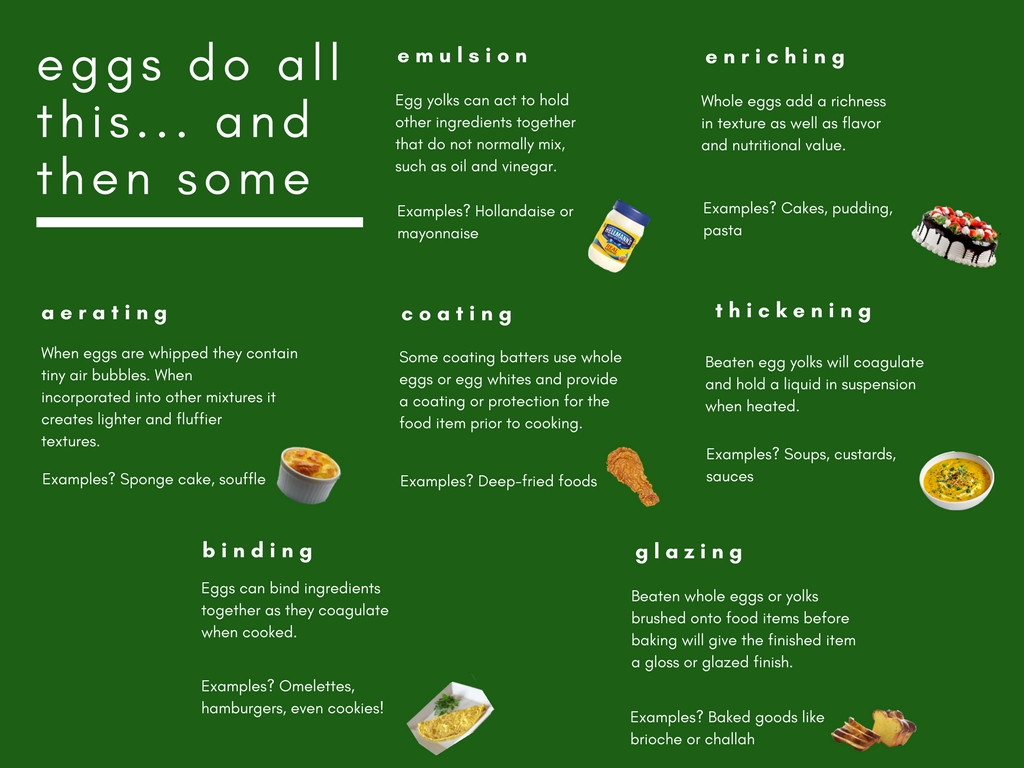
Hillary Bonhomme
That first success typifies Tetrick’s approach over the past seven years, a strategy now ubiquitous among the food-tech startups of Silicon Valley: Make a bunch of money by promising investors the moon, pour the funds into sophisticated R & D, and hope a game-changing product materializes before the cash runs out. (When all else fails, double down; repeat.) With each new funding round, of course, the expectations grow—so the fact that Just has raked in $310 million in startup capital to date, according to the startup tracker CrunchBase, doesn’t just mean the investors hope to recoup that sizeable amount of money. It means they expect an exponential return on their investment—a tall order that, at this point, warrants nothing short of a plant-based substitute powerful enough to change the way we eat.
“If you could choose to master a single ingredient, no choice would teach you more about cooking than an egg. It is an end in itself; it’s a multipurpose ingredient; it’s an all-purpose garnish; it’s an invaluable tool. […] It instructs in the way proteins behave in heat and in the powerful ways we can change food mechanically. It’s a lever for getting food to behave in great ways. Learn to take the egg to its many differing ends, and you’ve enlarged your repertoire by a factor of ten.”
Thanks to their protean capacity, eggs are everywhere. And a viable egg replacement product—one that can replicate the egg’s versatility at a fraction of the cost, while sidestepping the expensive and unphotogenic prospect of raising chickens—could be enormously lucrative.
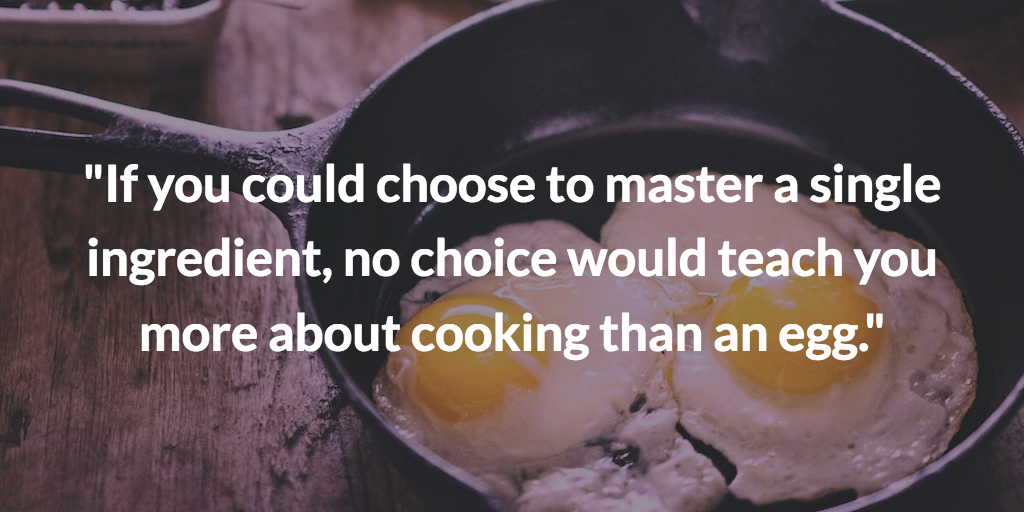
If you wanted to replace a common animal protein with something man-made, there’s one obvious place to start: with the incredible, edible egg
Gabriel Gurrola
But the egg’s versatility also makes it incredibly difficult to replicate. Egg Beaters, the well-known substitute made by the packaged food conglomerate ConAgra, don’t count, because that product really is eggs: It’s an egg-white solution—the real thing with the yolks stripped out. Convincing plant-based “replacement egg” products have been much harder to come by, and not just because of issues with taste and texture. Harold Bollaci, who makes a soy-based powdered “egg” product called The Vegg, says one key hurdle is creating a liquid solution that pours and cooks like freshly-cracked, whisked eggs. The extra step of adding liquid to a powder is just something most cooks and food manufacturers don’t want to deal with.
“The all-in-one aspect of getting a powder based egg and packaging it with liquid so that it’s a one-step shake and pour is extremely difficult,” he said. “Everyone I know is trying to deal with this. That is a really big obstacle, because all of the food managers I talk to say, ‘we need the easiest possible method of use for our kitchens, and shake and pour is it.’ Even though adding water and mixing seems easy to you and me, it’s not in a big kitchen.”
A truly disruptive egg substitute won’t just look like an egg and taste like an egg, in other words—it will pour like an egg and cook like egg, too. That’s why Just has been working for years to perfect a product that performs like an egg in the pan. The original approach, pea protein, didn’t work so well, but it did make a great emulsifier—so Hampton Creek pivoted to condiments for the whole early life of the company, jumping headfirst into manufacturing its now-famous eggless mayonnaise, Just Mayo. Tetrick refashioned the pitch, arguing that a cheap-to-make, plant-based vegan spread that didn’t compromise on taste could undercut traditional food companies on price, winning a large share of the $20-billion domestic mayonnaise market.
Just Scramble’s debut is a potential watershed moment in the history of food manufacturing.
Today, Just Mayo can be found at stores high- and low-brow, from Whole Foods to Dollar General. And yet, the extent of its success is hard to determine—not just because it was a kind of consolation prize, an iteration of the eggless-egg scramble Tetrick had failed to deliver. Yes, the product has generated lots of buzz over the years, both for its novelty and for Hampton Creek’s widely-publicized spat with the consumer goods behemoth Unilever, which tried to provoke the Food and Drug Administration (FDA) into ruling that a product labeled with the word “mayo” must, by law, contain eggs. (Ultimately, FDA—and the court of the public opinion—sided with Hampton Creek on that.) But the company itself has been so overshadowed by Tetrick’s misadventures that it’s difficult to tell whether Just Mayo has been a runaway hit or merely oversold hype.
In a 2016 profile, Bloomberg Businessweek made some dramatic allegations. It reported that Tetrick wooed investors with overblown projections, then faked success with a secretive product buyback program, a charge the company vehemently denies. Then there were the reported accusations of fraud, with Ali Partovi, a prominent early investor, backing out after claiming to have been misled. In 2017, Hampton Creek’s entire board resigned, leaving just Tetrick at the helm, while Target pulled Just Mayo from its shelves, citing unspecified food safety concerns. Though FDA determined there no wrongdoing on Just’s part, and the company has appointed prestigious new board members, it’s hard not to see the name change—from Hampton Creek to Just—as a PR reboot, a last attempt to try and leave all that baggage in the past.
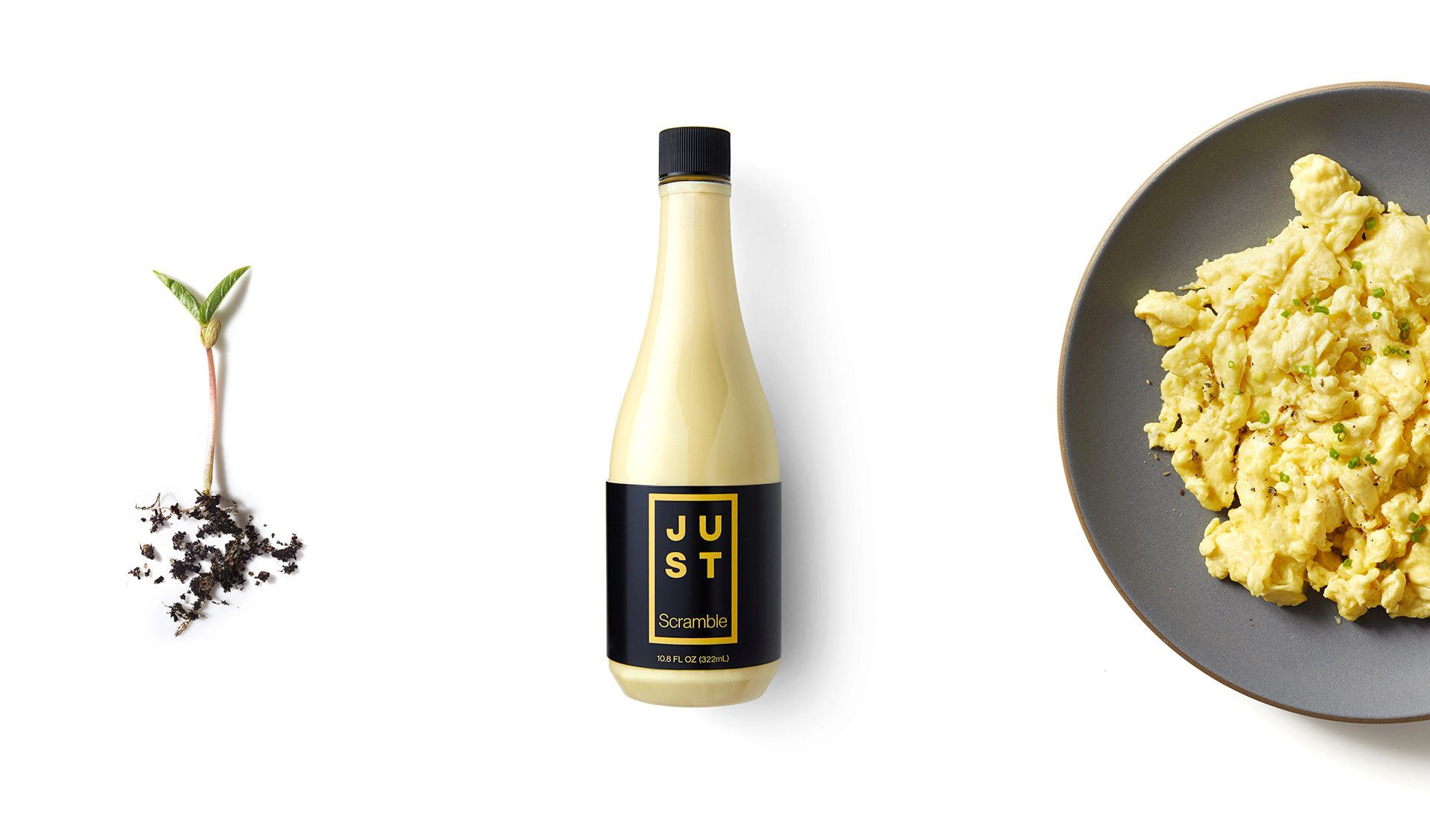
Just has been pitching investors on eggless eggs for a long time—since 2011, back when the company was still called Hampton Creek
Just, Inc.
So far, Just doesn’t have all that much to show for its $310 million. Its line of mayos and dressings, plus a plant-based cookie dough, are the only products it sells directly to American eaters. Then there’s the vegan cookies and cookie dough it sells through food service companies, including Compass, and several thousand local schools and institutions. It’s not exactly world domination. But a successful plant-based egg scramble—the original product Tetrick pitched all those years ago, and the food industry’s version of a killer app—could change all that. Which is why the Just Scramble’s debut isn’t any ordinary product launch. It’s the fulfillment of a years-old promise, a potential watershed moment in the history of food manufacturing, and ultimately what will determine whether Tetrick is a visionary or a charlatan.
—
In December, I went to taste the scramble at Just’s San Francisco headquarters. The combined office space and R & D lab is located in a large, industrial building with a history that combines the reality of commercial food manufacturing with larger-than-life dreams: It housed a bread company before it was repurposed into Disney/Pixar soundstages. The main floor looks like it could be an office anywhere in Silicon Valley: an open floor plan with more than 100 employees stationed at glowing Macs, Etta James floating softly from the speakers, and inspirational posters with words like “LEAP” and “DARE.” But elsewhere, things get very strange indeed.
First, my guide—Just’s communications lead, Andrew Noyes—took me downstairs, into a noticeably cold room jammed with dozens of large, cylindrical bins. Each one held a variety of plant proteins to be analyzed. There were seeds, roots, leaves, and legumes—sometimes in raw form and sometimes milled into flour onsite—to be chemically dissected and studied for special attributes using artificial intelligence. This is how next-generation plant-based companies have managed to go beyond the Boca Burger: By using AI to scan huge volumes of genetic and nutritional information, isolating the properties that make meat meat, and trying to reproduce them exactly using plants.
At a time when Americans are eating more meat than ever, why are American food companies trying to wean us off?
In another room, where Just works toward developing the right texture and mouthfeel for its products, a mechanical arm whirled in a cage. The machine is typically used to test the viscosity of industrial paints, but in this case was put to use in the name of ideal mayo consistency. The machines used to study plant biochemical properties were large and imposing, but they were humanized by signs bearing funny nicknames like “Randy Johnson.” Like the former Yankees pitcher, Just’s machines are workhorses, big units that provide a complete chemical inventory for more than 30 plant proteins every month. Downstairs, there was a four-aisled fake grocery store, featuring mostly condiments, a way to demonstrate to guests the fine, disruptive figure Just products cut on the shelves. Then I entered the “clean meat lab,” where I met Bowman—Just’s resident chef and product designer, the one who served up nuggets of lab-grown Ian for the company’s chicken nugget promo.
Bowman was bearded and solidly built, with a chef’s forearms. (Before moving to Just, he cooked at the acclaimed Chicago restaurant Moto; now, he spends his days working on product development.) Behind him, beakers of pinkish liquid swished on endlessly rocking platforms. What looked like grapefruit juice was actually a nutrient solution, he told me, where cells were dividing and multiplying as we spoke.
One day, Bowman told me, my chicken breast, my bluefin tuna, and my kobe beef won’t have to come from animals that walk or swim. They will be grown in massive warehouses with unthinkable output capacity. He pulled out some mounted pen-and-ink drawings, about the size of a classroom map. The first was a rendering of a hypothetical farm of the future, viewed from the air. To me, it looked like an industrial slaughterhouse—a large, warehouse-like building jutting with tankers and pipes. A facility like this one, Bowman told me, might be the size of a standard feedlot in Nebraska—but could theoretically produce 10 times the meat in the same space. That’s because of the way cells grow exponentially, which, Bowman said, means only 10 doublings can result in 66 million kilograms of meat.
It was hard to tell how seriously to take these claims.
The second drawing shows a scene with people in it. It’s something like the glass abattoir Michael Pollan invokes in The Omnivore’s Dilemma: A meat production facility with see-through walls, where the public is encouraged to peer inside. In this rendering, onlookers can see through a long window onto a conveyor belt carrying an endless sequence of meat patties. Couples stand together gawking in tandem; a mother puts her hand on a daughter’s shoulder. The implication is obvious: If today’s meat production is something to hide, a shame that takes place behind closed doors, hidden from the public but for the grainy films from animal rights activists, meat production of the future will invite participation. It will be clean, wholesome, environmentally benign, and it won’t require any killing. We’ll all look on, because there won’t be anything to hide.
It was hard to tell how seriously to take these claims. The clean meat lab didn’t look like much, after all—it was hardly bigger than a bedroom, and felt more like a museum diorama than a real production facility. I thought about Just’s history of hyping products that never really came to market, how out-of-step the small, stagey space felt with Bowman’s promises of mega-scale output, how gaming journalists like me is one way food startups raise huge amounts of money. But I didn’t have time to think long, because then my PR handler whisked me into Just’s kitchen for the egg tasting.
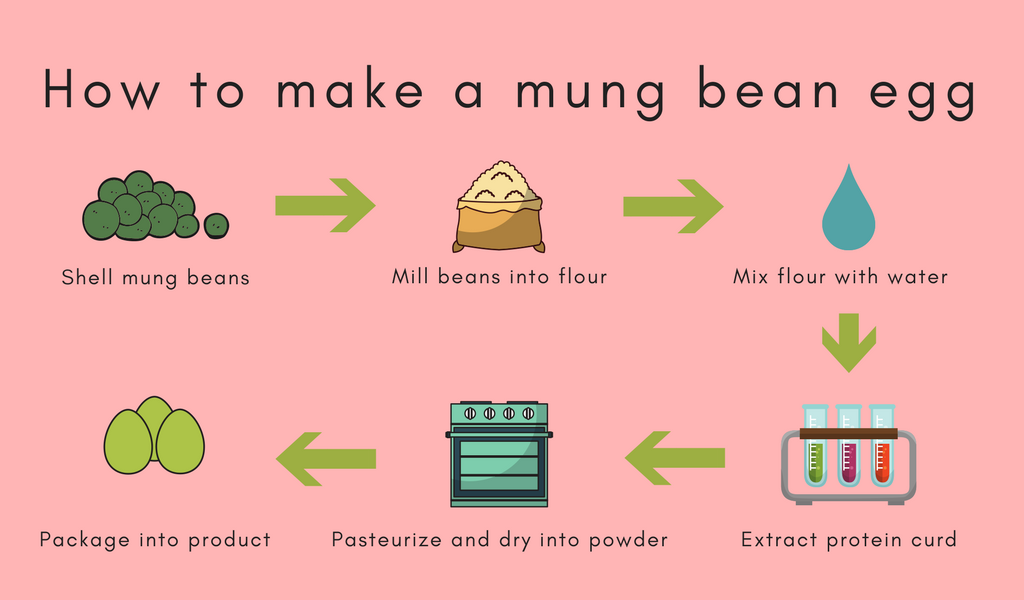
Mung beans are a nutrient-rich legume popular in Southeast Asia
Jessica Fu
I ate the Just Scramble in a clean, white test kitchen, helmed by Ben Roche, another of Just’s research and development chefs. In his former life, Roche was the pastry chef at Moto—where he worked with Bowman—so he knows his way around a pan. The challenge for the company, he told me, was to replicate the mundane, familiar experience of cooking an egg, and getting the scramble to perform the same way an actual egg would when it hits a hot surface.
“It needs to work quickly. The texture needs to be right. It should feel like you’re cooking with a chicken egg,” Roche said. “This isn’t like the mayo, where it’s a ready-to-eat product out of a jar. There’s another element to it, an experience element to it. If it doesn’t feel like the real thing, then it becomes a weird sort of science project—and no one wants to eat that.”
Roche poured the scramble into the heated pan, and the result was fairly uncanny. It looked just like a scrambled egg, only paler, with the familiar, cloudy viscosity. I recognized the process from the countless number of eggs I’ve scrambled over the years, though I’d never thought so much about the specifics until that moment: the way the liquid firms up around the edges first, then fluffs up into mounds as it is stirred. To achieve those everyday qualities, Roche explained, was a major technical achievement.
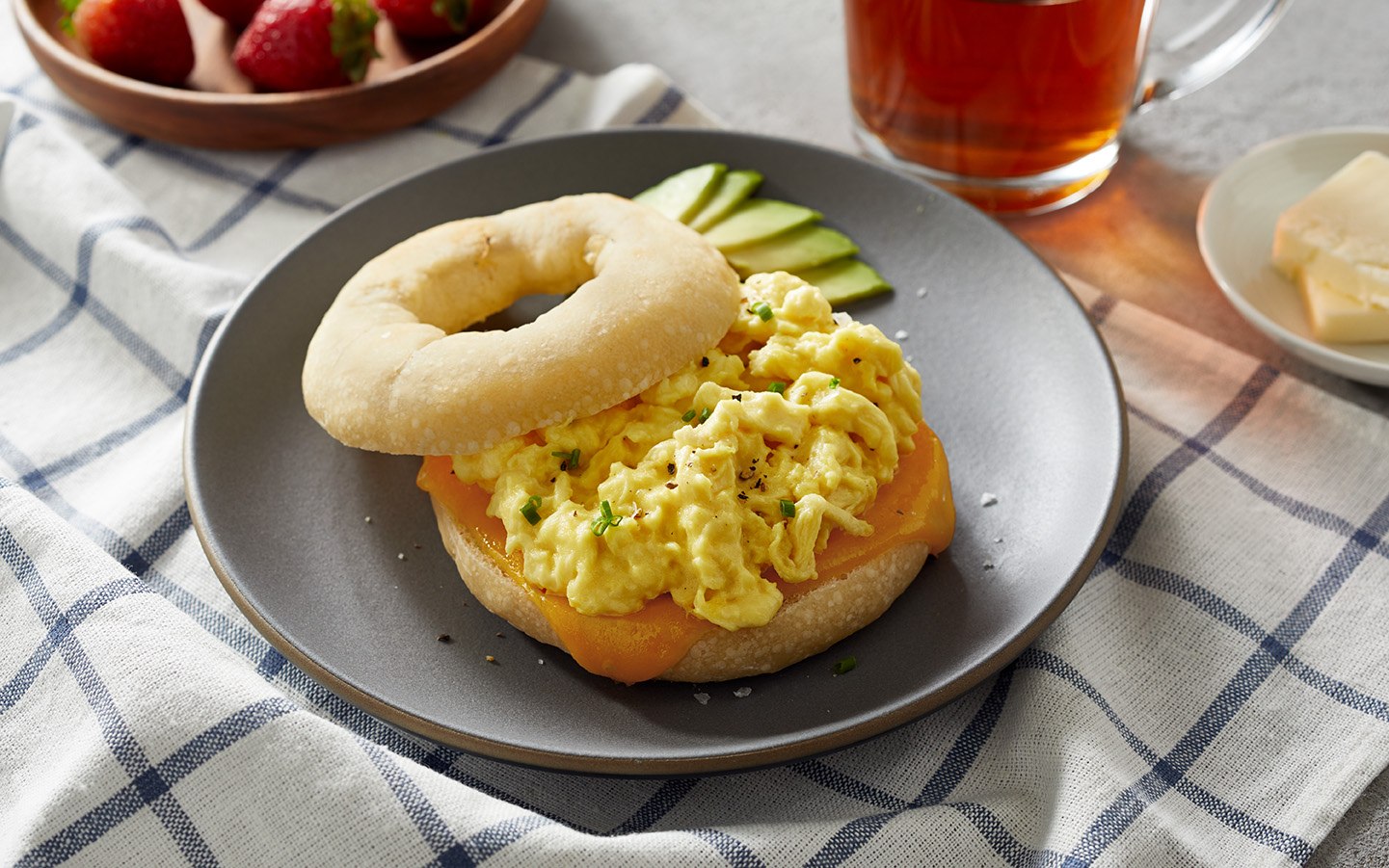
A publicity photo of the Just Scramble on a bagel
Just, Inc.
“Basic stuff that you normally don’t think about when you’re cooking an egg, we have to really analyze and categorize,” he said. “When you’re cooking eggs, you want it to form in these layers in the pan. As soon as it hits the pan, it forms the first layer; as you move it around, the liquid is then just hitting the pan again and forming another layer. That’s really what builds volume, and that contributes to the texture and mouthfeel that you’re getting.”
Within just a minute, the dish was ready; Roche piled the result out onto my plate. Then, to my surprise, he sprinkled some dark hunks of rough-hewn salt on the dish before I could start eating.
“So, we’re still developing the flavor profile of this,” he said. “Part of that includes incorporating the salts on top.” The black salt, he told me, contained eggy sulfur compounds that impart a more natural taste. Ultimately, he said, the company will work with flavor manufacturers to include it in a liquid form so that the salt can mix directly with the product and be poured without an extra step.
To me, it seemed like cheating. I couldn’t imagine spending years and millions of dollars trying to approximate a real-life egg if, at the end, you always had to sprinkle some flavor crystals on top. But when I took a bite, it was clear why Just still needs its special salt. The flavor is not especially egg-like. You can taste the mung-bean origins, a mild, not-unpleasant grassiness I associate with tofu. The taste is perfectly fine; I liked it. It just didn’t especially taste like eggs.
What was impressive, though, was the texture, which felt exactly like scrambled eggs in my mouth. If I’d had a cold, I might not have been able to tell anything was amiss. And that’s maybe the more important thing. When Roche served me some on a bagel, the experience was comfortingly familiar: With each bite, the subtle give of the cushion between the bread, an experience that’s become familiar through years of being human. If I ate it in a breakfast burrito, mixed up with beans and rice and hot sauce, I might not even know the difference.
The taste is perfectly fine; I liked it. It just didn’t especially taste like eggs.
Which raises the question: How high is the verisimilitude bar, really? Plenty of people would be drawn to the Just Scramble not for the taste, but for the novelty, the sustainability angle, the way it completely sidesteps anxiety-provoking terms like “cage-free.” Food manufacturers are even easier to please. They mostly want a cheap ingredient that performs the way they need it to. If a plant-based alternative can save the Nestles and Proctor and Gamble’s of the world pennies on the dollar in store-bought baked goods, you know they’ll want to make the switch—and they’ll put their vast advertising budgets into convincing us it’s for the best. History suggests they’ll be successful. The radical changes to the human diet that evolved over the past century were largely driven by the economics of production, not cultural fads. As emotional as we are about food, we’re also really malleable. That’s the funny thing about human beings: In time, we’ll get used to almost anything.
That’s been the experience of Jeff Linden, chief operating officer of Flore, the San Francisco restaurant that’s partnered with Just to serve the Scramble to its patrons. “There are people who are egg purists that are going to come in and say, ‘you know, it’s not quite eggs,’ and that’s true,” he told me. “However, for people that want a vegan or a healthy non-egg option it’s a breath of fresh air and they really enjoy it.”
Though both parties have benefited from the partnership in the form of good press, no money has changed hands aside from Linden buying Just’s Scramble at the same price he’d pay for shell eggs. He’s a relatively unbiased party, and told me the general reaction has been “overwhelmingly positive,” with roughly 70 percent of customers seeming delighted by the product; the Just Scramble is the third most popular egg dish on the menu. More importantly, he said, the line cooks at Flore have been able to use it without trouble. “It’s flavorful enough and it functions well, and I can eat it and still feel like I’m eating eggs.”
Perhaps the highest form of flattery came from an odd request. Linden said an “agricultural chemical group from the Midwest” wrote him asking for 40 samples of the product, which he denied.
“It was corporate espionage,” he said. “They wanted to take it and copy it.”
—
In the weeks that followed my visit to Just, I found myself thinking more and more about the drawings Bowman had showed me in the clean meat lab. The glass abattoir, the hyper-productive alt-meat plant—these things are still fantasies, probably hopeful ones. They are also marketing. They are trotted out to journalists on PR tours, a provocation designed to get people talking.
Still, they raised for me a series of nagging questions. I was convinced enough by what I tasted to believe we’re finally at the point where we can have meat-like protein without animals—if not right this minute, then very soon. And that’s unnerving because it’s a profound shift in the way we eat.

“Clean meat” is real, biological meat grown from cultured cells inside a lab
Just
Though, it’s not just that. Being able to eat meat without needing to raise animals would mark a watershed moment in the history of agriculture, and could forever change the way we relate to the livestock that have lived alongside our species for millennia.
To hear Just tell it, that would be a good thing. And why not be done with animals? Commercial egg-laying hens’ lives are inarguably nasty, brutish, and short: days spent crammed into battery cages or windowless, cage-free barns, induced by intervals of artificial light and total darkness to lay one mechanically collected egg every 30 hours. That system produces lots of cheap protein, but it’s incredibly wasteful in terms of natural resources. According to one peer-reviewed study, eggs have only about a 31-percent feed conversion rate, which means farmers feed conventional egg-laying hens more than three times the protein they actually produce. Plant-based companies argue that, rather than spend fuel and water growing animals and their feed, we should just learn to feed people directly with plants. We’d not only spare them the suffering, we’d spare our atmosphere the greenhouse gases they emit, and spare our streams and rivers their manure.
What we’re seeing here is, in part, an effort to privatize what has been a public good for the entire history of our species: animals.
Like most plant-based companies, Just has embraced this sustainability argument overtly. “By choosing Just over other leading brands, you’ve helped save at least 254,000,000 gallons of fresh water between January 1 and October 31, 2017—enough to fill more than at least 12,722 swimming pools,” the company writes on its website. “You’ve helped avoid emitting over at least 2,511,100 kilograms of greenhouse gases into the atmosphere—the equivalent of more than 196,116 cars kept off the road for a day.” The implication is that we can eat our way to a greener world, one dollop of plant-based mayonnaise at a time.
What this vision leaves out, though, is that not all forms of animal agriculture are so wasteful. A product like the Impossible Burger might look sustainable when compared to conventional beef production, which fattens feedlot cattle on tons of shipped-in grain, and collects the unusable manure that results in toxic waste lagoons. But how do Impossible’s sustainability metrics compare to farms that practice holistic grazing, where the cattle roam on pasture and help with weed control, as their manure builds topsoil and reduces the need for resource-intensive synthetic fertilizers?
No one really knows. It’s harder to make those comparisons, because so-called “regenerative agriculture,” working in tandem with animals and plants on a shared landscape, is complex, and harder to scale—and since it’s also harder to corporatize, lacks research dollars. Still, the Food and Agriculture Organization of the United Nations, like other advocates of diversified farming, says livestock-crop integration likely increases total land productivity, even if it can’t always outcompete the rate at which monoculture row crops or factory meat farms produce one single product. By comparing themselves only to the most resource-intensive forms of commodity farming—in Just’s case, commercial egg production—plant-based companies tend to choose talking points over more nuanced conversations about the role animals might play in sustainability.
For now, you don’t hear much about agricultural practices from alt-protein companies—whether they’re hoping to support vast, combine-harvested monocrops or more diversified systems. (There would be a certain irony in grazing animals on a landscape used to produce vegan meat replacements.) The lack of discussion about agricultural methods suggests that sustainability concerns don’t tell the full story. Because the other driver of the alt-protein revolution is, of course, money.

Alt-protein—in both its plant-based and lab-cultivated varieties—is intensely proprietary
Rachel Lees
The sudden cultural interest in meat replacement is a big bet, one being made from Silicon Valley to the corporate boardrooms of the Midwest, that Americans will eat alt-proteins if they taste exactly like what we’re used to. In other words, if food manufacturers can realistically simulate the taste and texture of meat, eggs, and dairy, we won’t care if our daily protein intake came from a stainless steel factory rather than a feedlot or pasture. More than that: we may even prefer our meat to have never involved animals in the first place, dispensing with all the messy baggage of slaughter.
That’s a risky proposition. But for investors the economics of alt-protein are almost too tantalizing to ignore. Think of it this way: a cow is the ultimate open-source animal. Anyone who can afford to can raise one, buy one, and sell its meat (provided they have the proper paperwork). But alt-protein—in both its plant-based and lab-cultivated varieties—is intensely proprietary. No one can sell the Impossible Burger except Impossible Foods; so far, the company has a virtual monopoly on plant-based ground beef hyperrealism. What we’re seeing here is, in part, an effort to privatize what has been a public good for the entire history of our species: animals.
And Just’s founder, Josh Tetrick, knows this. According to the 2016 Bloomberg profile, he’s recognized from the beginning that tech patents are the key to winning over investors on the VC pitching circuit—that the key to making money is to develop a new technique that one company owns completely. That should give us pause. The alt-protein factory of the future may have glass walls, and may contain nothing within it that incites human squeamishness at the idea of killing animals for meat. But it would also herald the rise of a new class of corporate food titan, a world where the protein we rely on to survive is not just food but intellectual property, the domain of corporations with millions in R & D money.
That shift may have unintended consequences that are worth discussing. After all, if and when alt-proteins become cheap, palatable, and profitable, would anyone go back to producing plain old everyday meat? Can cows and chickens and pigs, which take time and resources to raise, and which spend energy growing body parts we don’t eat—ears and tails and talons and beaks—ever compete with the meat-like counterparts that are grown one ribeye and filet at a time, at scale, in a lab? Animal agriculture is already a brutally hard business, one with little room for error economically. And when we can have meat without animals, it might be hard to remember why we wanted to raise animals in the first place.
“Part of living is killing.”
But the idea of decoupling meat and animals has powerful implications for the farmers and ranchers who make a living farming livestock—and not just the big producers running factory farms. I recently spoke with Doniga Markegard, who runs a grass-based cattle ranch in San Mateo County, California, and has been thinking about plant-based protein as she prepares to share the stage with Impossible Foods’ chief scientist at an upcoming panel. In her view, the squeamishness about slaughter that makes plant-based so appealing ironically leads to far more death.
“Part of living is killing,” she said. “I don’t care if you eat vegan or you eat meat, you are responsible for death. I would argue that if you’re vegan, you are responsible for way more death than if you eat a healthy, regenerative diet with grass-fed meat. As a regenerative rancher, it’s part of our responsibility to give more life than we take. We understand—because we understand nature—that every part of eating is killing, no matter what it is. A plant doesn’t have a heart or lungs, you’re right. But that crop field that that crop is growing on was once life to a huge diversity of plants, and animals, and birds, that are now gone. You are responsible for that patch of cropland killing that habitat, and killing all of those animals that could be living there—living there alongside your grass-fed steer, or living alongside your diversified agriculture crop.”
If Just’s progress is any indication, meat and animals may soon part ways. But it’s time to start asking what the consequences, intended and unintended, will be. It’s clear there is something to be gained through the rise of alt-protein. The question is how much will be lost.
Correction: An earlier version of this piece claimed that Just will debut a cultured chicken product in 2018. The company has pledged to release a “clean” meat product this year, and has said that it will likely be from the avian family, but has not been more specific.

